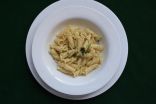(Press-News.org) A good or mediocre appetizer has the potential to significantly change how the main course is enjoyed, according to one Drexel food science professor.
Jacob Lahne, PhD, an assistant professor in the Center for Hospitality and Sport Management, recently found that a comparatively good appetizer could make people enjoy the main course less than if it were preceded by a mediocre appetizer.
Lahne tested and analyzed subjects' hedonic (liking) responses to a main dish of "pasta aglio e olio" (pasta with garlic and oil) after they had either a good or mediocre bruschetta appetizer. The good bruschetta was made with extra ingredients like balsamic vinegar and lemon zest, as well as fresher and better quality ingredients, like extra virgin oil and fresh basil compared to the blended olive oil and dried basil in the mediocre bruschetta.
The result? The good bruschetta was judged better than the mediocre bruschetta, but the pasta dish was liked more when preceded by the mediocre appetizer. One possible explanation for this result is that the very nature of the appetite-whetting first dish sways the consumer to compare it with the subsequent courses, to the latter's potential detriment.
"It's always worth remembering that our experiences are contextual--that is, what we like and don't like, or taste and don't taste, is not objective, but related to the environment, our state of mind, and many other variables. If you have a fantastic appetizer and then the main seems lackluster, that could be because of this type of contrast effect. That doesn't mean you shouldn't have fantastic appetizers!" said Lahne.
Lahne specializes in sensory evaluation, or the part of food science dedicated to understanding human sensory responses to foods (among other products). He says that there had been little research on how liking one dish might be influenced by other sequential foods in the meal until this study. With his co-author, Debra Zellner, PhD, a professor at Montclair State University, he published the findings of the study "The Great is the Enemy of the Good: Hedonic Contrast in a Coursed Meal" in Food Quality and Preference.
The study investigated whether the hedonic value of an appetizer affected the hedonic value of the subsequently eaten main course in a real-world meal setting (since hedonic contrast is typically tested laboratory settings). The study was tested on customers in the Academic Bistro, the Center for Hospitality and Sport Management's student-run, culinary-training restaurant, during January and February 2015. Dishes and ingredients were chosen based on the expertise of Chef Richard Pepino, executive chef of the Academic Bistro.
"I've always been interested in trying to understand the food choices people make, so doing research in Drexel's Academic Bistro as a unique study space seemed like a natural approach," Lahne said.
According to Lahne, the study was more targeted at chefs and other producers than consumers. He plans to continue researching the structure and limits of hedonic contrasts between dishes in real-world meals to better inform chefs, the food industry and home cooks.
INFORMATION:
Nature loves crystals. Salt, snowflakes and quartz are three examples of crystals - materials characterized by the lattice-like arrangement of their atoms and molecules.
Industry loves crystals, too. Electronics are based on a special family of crystals known as semiconductors, most famously silicon.
To make semiconductors useful, engineers must tweak their crystalline lattice in subtle ways to start and stop the flow of electrons.
Semiconductor engineers must know precisely how much energy it takes to move electrons in a crystal lattice. This energy measure is the ...
Scientists from UCL (University College London) have designed a chemical compound that has reduced the growth of pancreatic cancer tumours by 80 percent in treated mice.
The compound, called MM41, was designed to block faulty genes. It appears to do this by targeting little knots in their DNA, called quadruplexes, which are very different from normal DNA and which are especially found in faulty genes.
The findings, published in Nature Scientific Reports, showed that MM41 had a strong inhibiting effect on two genes -- k-RAS and BCL-2 -- both of which are found in the ...
Wading bird numbers in the Florida Everglades are driven by water patterns that play out over multiple years according to a new study by the U.S. Geological Survey and Florida Atlantic University. Previously, existing water conditions were seen as the primary driving factor affecting numbers of birds, but this research shows that the preceding years' water conditions and availability are equally important.
"We've known for some time that changes in water levels trigger a significant response by wading birds in the Everglades," said James Beerens, the study's lead author ...
Researchers from The University of Manchester are part of a team that has identified an important new approach to diagnose infections in critically ill patients rapidly and accurately.
A study by colleagues in Salford and Manchester found that chemically analysing breath specimens from patients in intensive care can reveal bacterial infection in the lower respiratory tract of ventilated patients at risk of developing pneumonia.
Although the work is in its early stages, the findings so far look very exciting and could potentially have a huge effect on clinical practice ...
A pioneering new technique to produce high-quality, low cost graphene could pave the way for the development of the first truly flexible 'electronic skin', that could be used in robots.
Researchers from the University of Exeter have discovered an innovative new method to produce the wonder material Graphene significantly cheaper, and easier, than previously possible.
The research team, led by Professor Monica Craciun, have used this new technique to create the first transparent and flexible touch-sensor that could enable the development of artificial skin for use in ...
Researchers at Ludwig-Maximilians-Universitaet (LMU) in Munich have used DNA barcoding to elucidate the diversity of the sponge fauna found in Antarctic waters. The data provide new insights into the evolution of this poorly characterized group.
Sponges constitute an important component of marine ecosystems in the waters around Antarctica. As filter feeders that rely on food particles suspended in the water passing through complex networks of canals lined with flagellated cells, they provide protected niches for many other organisms. "In spite of their considerable ecological ...
How a chimpanzee views a video of an infant chimp from another group being killed gives a sense of how human morality and social norms might have evolved. So says Claudia Rudolf von Rohr of the University of Zurich in Switzerland, lead author of a paper in Springer's journal Human Nature. It provides the first evidence that chimpanzees, like humans, are sensitive to the appropriateness of behaviors, especially those directed toward infants. It also shows that these primates might only take action when a member of their own group is being harmed.
The researchers filmed ...
Working with heart muscle cells from diabetic rats, scientists at Johns Hopkins have located what they say is the epicenter of mischief wreaked by too much blood sugar and used a sugar-gobbling enzyme to restore normal function in the glucose-damaged cells of animal heart muscles.
In addition to much-needed insight into the process of diabetes-related heart damage, the study, described June 24 in the journal Diabetes, offers a clue to a possible treatment strategy for diabetic cardiomyopathy, a condition marked by progressive weakening of the heart muscle found in 60 ...
Nashville, Tenn., June 25, 2015--Collecting and reporting hospital infection data to federal health agencies takes more than 5 hours each day, at the expense of time needed to ensure that frontline healthcare personnel are adhering to basic infection prevention practices such as hand hygiene, according to a recent case study, to be presented on Saturday, June 27 at the 42nd Annual Conference of the Association for Professionals in Infection Control and Epidemiology (APIC).
Infection preventionists (IPs) play a critical role in the effort to eliminate healthcare-associated ...
Nashville, Tenn., June 25 -- A pilot antibiotic stewardship program at a pediatric long-term care facility brought about a 59 percent decrease in use of a topical antibiotic and an 83 percent decrease in orders for antibiotics without proper documentation during a six-month period, according to a new study.
When the infection prevention team at Elizabeth Seton Pediatric Center in Yonkers, N.Y. noticed that certain antibiotics were being prescribed for a prolonged period of time and for non-infection indications, they launched a trial program to make improvements in antibiotic ...

